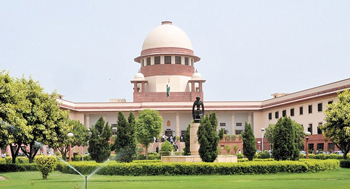Reference of Shlokas from Scriptures in the Supreme Court verdict on the Ram Janmabhoomi case

New Delhi – Reference of Valmiki Ramayan, Shlokas from Skanda Purana, Ramcharitmanas is also given in the verdict of the Supreme Court in the Ram Janmabhoomi case.
1. Ayodhya bestows Moksha
In Bruhad-dharmottara Purana, Ayodhya is referred to one of the seven sacred places in the following Shloka.
अयोध्या मथुरा माया काशी काञ्ची ह्यवन्तिका ।
पुरी द्वारावती चैव सप्तैता मोक्षदायिकाः ॥
Meaning : Ayodhya (in Uttar Pradesh), Mathura (in Uttar Pradesh), Maya means Haridwar (in Uttarakhand), Kashi (in Uttar Pradesh), Kanchi (in Tamil Nadu), Avantika means Ujjain (in Madhya Pradesh) and Dwarka (in Gujarat) are the seven most sacred places that bestow Moksha (Final Liberation).
2. Supreme Court has given reference of Balakanda in Valmiki Ramayan for referring to Shriram’s Divine virtues
The Supreme Court verdict contains a reference that Shriram possessed Divine virtues right from His birth. The Court referred to Balakanda in Ramayan for this.
प्रोद्यमाने जगन्नाथं सर्वलोकनमस्कृतम् ।
कौसल्याजनयद् रामं दिव्यलक्षणसंयुतम् ॥
Meaning : Kaushalya gave birth to a son who was the Lord of the whole world. He was a person adored by all the people. He was invested with Divine symptoms.
3. Foundation of Vaishnav Khanda of Skanda Purana
in which the which Ram Janmabhoomi is referred to
The Supreme Court has made an observation about Ram Janmabhoomi while referring to the incidents narrated in Vaishnav Khand of Skandpurana.
तस्मात्स्थानत ऐशाने रामजन्म प्रवर्त्तते ।
जन्मस्थानमिदं प्रोक्तं मोक्षादिफलसाधनम् ॥
विघ्नेश्वरात्पूर्वभागे वासिष्ठादुत्तरे तथा ।
लौमशात्पश्चिमे भागे जन्मस्थानं ततः स्मृतम् ॥
Meaning : To the North-East of that spot is the birthplace of Shriram. This Holy spot of the birth is said to be the means of achieving salvation. It is said that the birthplace is situated to the East of Vighnesvara, the North of Vasishtha and to the West of Laumasa. According to local Hindus beliefs, ‘Laumasa’ or the place of ‘Laumasa’ is identical with the Rin Mochan Ghat.
4. Reference to Sikh Dharmaguru
Guru Nanakdevji’s visit to Ayodhya
The Bench of 5 Justices of the Supreme Court has refered to the pilgrimage of Guru Nanakdevji in which He visited Ayodhya. After getting the Divine vision of God on the auspicious day of Bhadrapad Pournima 1564 Vikrami = 1507 C.E., Guru Nanakdevji prepared Himself for the pilgrimage. He went to Ayodhya via Delhi, Haridwar, Sultanpur, etc. This journey took 3-4 years.
Likewise, Guru Nanakdevji went on a pilgrimage to see Ram Janmabhoomi Mandir in 1567-1568 Vikrami = 1510-11 C.E. It is mentioned here that Babar has not invaded India by that time.
5. References from books written by Dr. Sarvapalli Radhakrishnan and Monier Williams were taken while defining ‘Hindutva’
The Supreme Court made a reference to the Chapters written by Shastri Yadnyaprasadji, Muldas Bhudhardas and others. The Court observes in the verdict – ‘There is no Messenger in Hindu Dharma like the other religions. You can call Hindu Dharma as a lifestyle to lead on an expansive base; nothing else’. The verdict also makes a reference to ‘The Hindu view of life’ written by Dr. Sarvapalli Radhakrishnan and ‘Religious thought and life in India’ written by Monier Williams.
SC sought the support of travel logs of foreign authors for Ayodhya verdict
Foreign travellers of the past, especially those with a penchant for writing, had their hands full while travelling across India. While giving its verdict on the Ram Janmabhoomi case, the Supreme Court sought the support of some travel logs.
The accounts written by Jesuit missionary Father Joseph Tieffenthaler, Anglo-Irish author Robert Montgomery Martin as well as by other authors have been mentioned in the verdict. These accounts carry a comprehensive description of the faith and belief of the Hindus. Based on these articles and accounts, it has been concluded that Deity Shriram was verily born on the land of Ram Janmabhoomi and Hindus have been worshipping this place for ages.
Mention of Seeta-Rasoi (Kitchen), Swargadwar (Gate of Paradise) and a Bhandar in Ram Mandir premises before 1785 : British merchant William Finch, who visited Ayodhya between 1608-1611 and Tieffenthaler did so from 1743 to 1785. In the descriptive accounts written during their travel across India, they have also written about Ayodhya. These logs find a mention of Hindus worshipping Deity Shriram at the Ram Janmabhoomi. Especially, Tieffenthaler has mentioned Seeta-Rasoi, Swargadwar and a Bhandar in his logs. These references prove that Deity Shriram was born there.
An overseas author writing about Bhagawan Shri Vishnu taking birth as Shriram : Tieffenthaler says that at the venue where Bhagawan Shri Vishnu took birth as Shriram, many devotees worship Shriram collectively. The structure there was demolished by Aurangzeb or Babar. In Shriram Mandir, there were three paths of parikrama (Circumambulation). Hindus performed puja (Worship) in this Mandir.
This report dates back to a period pre-18th Century as well as before the construction of the brick wall after Hindu-Muslim riots during the British rule.